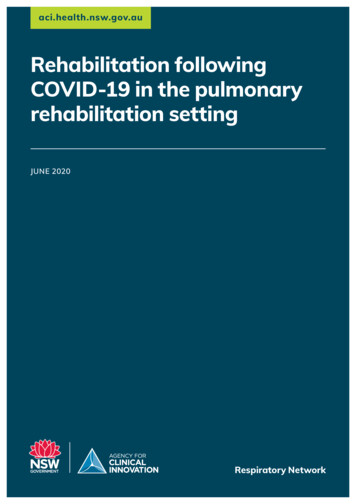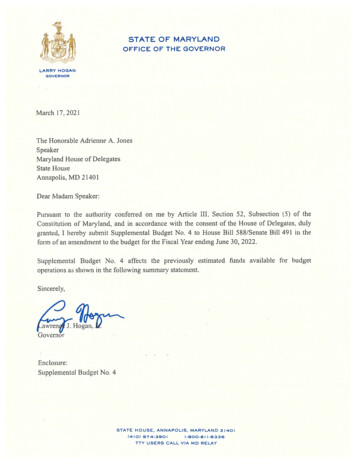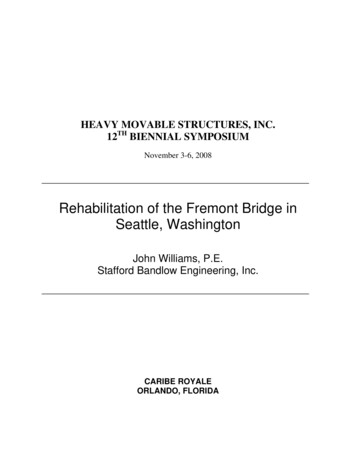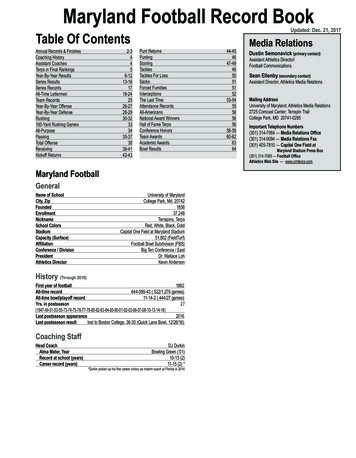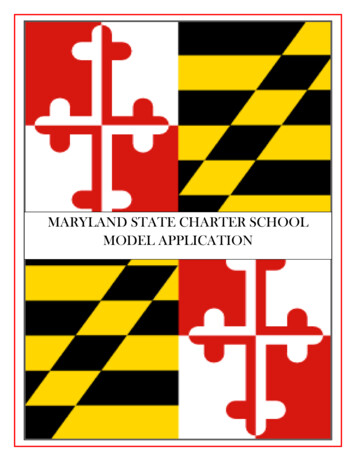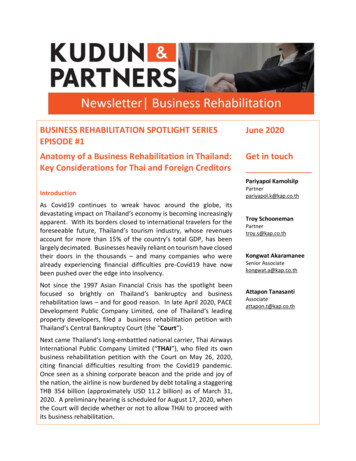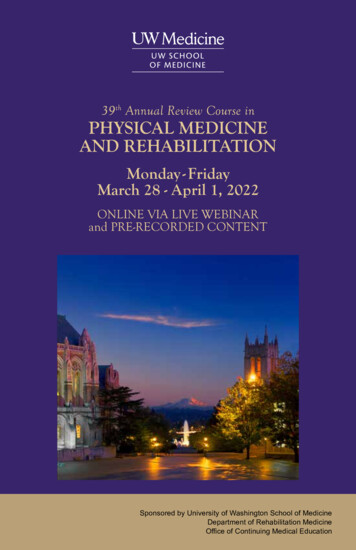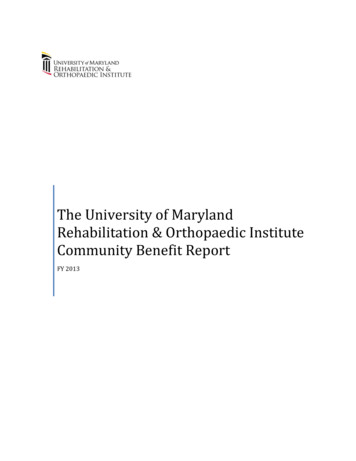
Transcription
The University of MarylandRehabilitation & Orthopaedic InstituteCommunity Benefit ReportFY 2013
I.GENERAL HOSPITAL DEMOGRAPHICS AND CHARACTERISTICS:Please list the following information in Table I below. For the purposes of this section, “primaryservices area” means the Maryland postal ZIP code areas from which the first 60 percent of ahospital’s patient discharges originate during the most recent 12 month period available, where thedischarges from each ZIP code are ordered from largest to smallest number of discharges. Thisinformation will be provided to all hospitals by the HSCRC.BedDesignation:Total Beds:144ProgressiveCare Unit: 10ICU: 5InpatientRehabilitation:Stroke: 28 bedsTraumaticBrain Injury:37 bedsSpinal Cord &Multi-TraumaInjury: 32 bedsComprehensiveMedicalRehabilitation:32 bedsInpatientPrimaryAll otherMarylandAdmissions: ServiceAreaHospitalsZipSharing PrimaryCodes:Service 211362072321144St. AgnesSt. AgnesSt. AgnesSt. AgnesHoward Co GenHoward Co GenHoward Co GenHoward Co GenMD GeneralSinaiBWMCCarroll HospitalUMMCBWMCHoward Co GenHarbor HospitalNorthwest HospNorthwest HospCarroll HospitalSinaiFranklin SquareNorthwestBWMCSinaiHoward Co GenHarbor HospitalJH BayviewBWMCNorthwestLaurel RegionalBWMCPercentage ofUninsured Patients,by County:Allegany 20%Anne Arundel 6.3%Baltimore 5.5%Baltimore City10.2%Calvert 5.0%Caroline 21.4%Carroll 10.3%Cecil 10.5%Charles 7.7%Dorchester 20.0%Frederick 11.7%Garrett 0.0%Harford 10.0%Howard 1.6%Kent 7.1%Montgomery 14.0%Prince Georges 12.7%Queen Anne 8.7%Somerset 0.0%St. Mary’s 0.0%Talbot 11.1%Wicomico 9.1%Worcester 10.0%Washington 20.0%Unidentified MD18.2%Washington DC 0%W. Virginia 20.0%Delaware 11.1%Pennsylvania 2.9%Virginia 11.1%Other State 15.6%Percentage of Patientswho are MedicaidRecipients, by County:Allegany 0.0%Anne Arundel 10.1%Baltimore 10.7%Baltimore City 24.8%Calvert 20.0%Caroline 28.6%Carroll 7.1%Cecil 42.1%Charles 26.9%Dorchester 20.0%Frederick 13.0%Garrett 0.0%Harford 18.9%Howard 3.0%Kent 14.3%Montgomery 30.0%Prince Georges 21.8%Queen Anne 8.7%Somerset 100.0%St. Mary’s 12.5%Talbot 11.1%Wicomico 27.3%Worcester 30.0%Washington 30.0%Unidentified MD 18.2%Washington DC 66.7%W. Virginia 10.0%Delaware 33.3%Pennsylvania 5.9%Virginia 0.0%Other State 3.1%For purposes of reporting on your community benefit activities, please provide the followinginformation:
Describe in detail the community or communities the organization serves:The University of Maryland Rehabilitation and Orthopaedic Institute (UM Rehab & Ortho) is the largestinpatient rehabilitation specialty hospital located in Maryland. Formerly known also as Kernan Orthopaedicsand Rehabilitation, the hospital is Baltimore’s original orthopaedic and rehabilitation specialty hospital and is acommitted provider of a full array of rehabilitation programs and specialty surgery--primarily orthopaedics. Amember of the University of Maryland Medical System (UMMS) and affiliated with the University of MarylandSchool of Medicine, the hospital has been serving patients who are residents of the State of Maryland and thesurrounding Baltimore metropolitan area for over 116 years.UM Rehab & Ortho at a Glance (FY 2013)144 Rehabilitation, Chronic and Acute Care Beds6 Operating Rooms3,465 admissions, 2850 orthopaedic surgeriesAmbulatory Visits - 76,720Medical Staff – 250o 237 Physicians representing 44 specialties 180 University of Maryland School of Medicine Facility 57 Community physicianso 25 Mid-Level Providerso 29 Dentists686 Full and Part-Time Staff44% nursing positions20% Therapy positions36% All other positionsLocated in the Forest Park/Gwynns Falls community in southwest Baltimore City, and the GwynnOak/Woodlawn area in western Baltimore County, UM Rehab & Ortho is accessible to patients residing inBaltimore City, Anne Arundel, Baltimore, and Howard counties.Approximately 18 percent of UM Rehab & Ortho patients are admitted to the hospital for electiveorthopaedic surgical procedures. Patients requiring rehabilitative care comprise the other 82 percent ofadmissions and are patients who are transferred to UM Rehab & Ortho from acute care hospitals thatare located throughout the state of Maryland. During FY 2013, 33 percent of Baltimore City patientsrequiring rehabilitative care were treated at UM Rehab & Ortho. Statewide, 28 percent of thoseneeding post-acute rehabilitation were cared for at UM Rehab & Ortho.As the largest provider of acute spinal cord injury rehabilitation in the State of Maryland, UM Rehab& Ortho treated approximately 50 percent of central Maryland's spinal cord injury patients, and 38percent of spinal cord injury patients statewide. The largest provider of acute traumatic brain injuryrehabilitation in the State of Maryland, UM Rehab & Ortho treated 66 percent of those patient incentral Maryland, and 61 percent statewide.The following information details the areas UM Rehab & Ortho serves --Baltimore City, Anne Arundel,Baltimore, and Howard counties. For purposes of this report, UM Rehab & Ortho’s CBSA could be consideredthe following zip codes, by city and county:Baltimore CityAnne Arundel CountyHoward CountyBaltimore County212012114421043 2120721208212022106121044 2121521117212172112221045 212092122821216210602107521229
Baltimore City, MarylandBaltimore city consists of nine geographical regions: Northern, Northwestern, Northeastern, Western, Central,Eastern, Southern, Southwestern, and Southeastern. The West Baltimore community is nearest to UM Rehab &Ortho Institute, and consists of the Northwestern, Western, and Southwestern districts. The Northwesterndistrict, bounded by the Baltimore County line on its northern and western boundaries, Gwynns Falls Parkwayon the south and Pimlico Road on the East, is home to Pimlico Race Course, where the Preakness Stakes takesplace each May, and is primarily residential.The Western district, located west of the main commercial district downtown, is the heart of West Baltimore,bounded by Gwynns Falls Parkway, Fremont Avenue, and Baltimore Street. Coppin State University,Mondawmin Mall, and Edmondson Village, all located within this district, have been historic cultural andeconomic centers of the city's African American communityThe Southwestern district is bounded by Baltimore County to the west, Baltimore Street to the north, and thedowntown area to the east. Economic and demographic characteristics of Southwestern district vary.DemographicsAccording to the 2010 U.S. Census, the latest data available, there were 621,342 people residing in Baltimore,an increase of .01% since 2010. According to the 2010 U.S. Census, 29.6% of the population was non-HispanicWhite, 63.7% non-Hispanic Black or African American, 0.4% non-Hispanic American Indian and AlaskaNative, 2.3% non-Hispanic Asian, 0% from some other race (non-Hispanic) and 2.1% of two or more races(non-Hispanic). 4.2% of Baltimore's population was of Hispanic, Latino, or Spanish origin. In the 1990s, the USCensus reported that Baltimore ranked as one of the largest population losers alongside Detroit and WashingtonD.C., losing over 84,000 residents between 1990 and 2000.The same report also estimated these people lived in a total of 294,579 housing units. Age ranges were 22.4%under 18 years old, 11.8% at age 65 or older, and 65.8% from 18 to 64 years old. The city's estimated 2009population of 637,418 was 53.4% female.A statistical abstract prepared by the U.S. Census Bureau estimated the median income for a household in thecity during 2009 at 38,458, with 20.9% of the population below the poverty line.People QuickFactsPopulation, 2012 estimatePopulation, 2010 (April 1) estimates basePopulation, percent change, April 1, 2010 to July 1, 2012Population, 2010Persons under 5 years, percent, 2010Persons under 18 years, percent, 2010Persons 65 years and over, percent, 2010Female persons, percent, 2010White alone, percent, 2010 (a)Black or African American alone, percent, 2010 3,5526.3%23.4%12.3%51.6%58.2%29.4%
American Indian and Alaska Native alone, percent, 2010 (a)Asian alone, percent, 2010 (a)Native Hawaiian and Other Pacific Islander alone, percent, 2010 (a)Two or More Races, percent, 2010Hispanic or Latino, percent, 2010 (b)White alone, not Hispanic or Latino, percent, 2010Living in same house 1 year & over, percent, 2007-2011Foreign born persons, percent, 2007-2011Language other than English spoken at home, percent age 5 , 20072011High school graduate or higher, percent of persons age 25 , 2007-2011Bachelor's degree or higher, percent of persons age 25 , 2007-2011Veterans, 2007-2011Mean travel time to work (minutes), workers age 16 , 2007-2011Housing units, 2010Homeownership rate, 2007-2011Housing units in multi-unit structures, percent, 2007-2011Median value of owner-occupied housing units, 2007-2011Households, 2007-2011Persons per household, 2007-2011Per capita money income in the past 12 months (2011 dollars), 20072011Median household income, 2007-2011Persons below poverty level, percent, 29.6296,68549.5%32.8% 163,700238,9592.50 23,85388.2%36.1%443,65231.72,378,81468.7%25.4% 319,8002,128,3772.63 35,751 40,10022.4% 72,4199.0%Source: US Census Bureau Quick Facts 2010Baltimore County, MarylandA part of the Baltimore-Washington Metropolitan area, Baltimore County is located in the northern part of thestate of Maryland. In 2010, the county’s population was 805,029. Comprised of approximately 598 squaremiles, Baltimore County does not have any incorporated cities or towns and is divided into council districts.UM Rehab & Ortho is located on the southwestern border of district 4 (Randallstown/Woodlawn/Security) ofthe county and Baltimore City.DemographicsAccording to the 2010 Census QuickFacts, the latest data available, the population and demographics ofBaltimore County were as follows:
White persons comprised 64.8 percent of the population, with Black persons accounting for 27 percent of thecounty’s population. American Indian and Alaska Native persons made up .04 percent of the population, Asianpopulation comprised 5.4 percent, with Native Hawaiian and other Pacific Islander at .01 percent. Personsreporting two or more races made up percent of Baltimore County’s population, persons of Hispanic or Latinoorigin, totaled 4.6 percent. The percent of White persons, not Hispanic was 61.4 percent.There were 315.127 households out of which 30.20% had children under the age of 18 living with them,49.40% were married couples living together, 12.80% had a female householder with no husband present, and33.80% were non-families. 27.30% of all households were made up of individuals and 10.10% had someoneliving alone who was 65 years of age or older. The average household size was and the average family sizewas 3.00.In the county the population was spread out with 23.60% under the age of 18, 8.50% from 18 to 24, 29.80%from 25 to 44, 23.40% from 45 to 64, and 14.60% who were 65 years of age or older. The median age was 38years. For every 100 females there were 90.00 males. For every 100 females age 18 and over, there were 86.00males.The median income for a household in the county was 65,411.00, and the median income for a family was 59,998. Males had a median income of 41,048 versus 31,426 for females. The per capita income for thecounty was 34,304.0. About 8.2% of the population was below the poverty line, including 7.20% of thoseunder age 18 and 6.50% of those aged 65 or over.People QuickFactsPopulation, 2012 estimatePopulation, 2010 (April 1) estimates basePopulation, percent change, April 1, 2010 to July 1, 2012Population, 2010Persons under 5 years, percent, 2012Persons under 18 years, percent, 2012Persons 65 years and over, percent, 2012Female persons, percent, 2012White alone, percent, 2012 (a)Black or African American alone, percent, 2012 (a)American Indian and Alaska Native alone, percent, 2012 (a)Asian alone, percent, 2012 (a)Native Hawaiian and Other Pacific Islander alone, percent, 2012 (a)Two or More Races, percent, 2012Hispanic or Latino, percent, 2012 (b)White alone, not Hispanic or Latino, percent, 2012Living in same house 1 year & over, percent, 2007-2011Foreign born persons, percent, 2007-2011Language other than English spoken at home, percent age 5 , 2007-2011High school graduate or higher, percent of persons age 25 , 2007-2011Bachelor's degree or higher, percent of persons age 25 , 2007-2011Veterans, 2007-2011Mean travel time to work (minutes), workers age 16 , 2007-2011Housing units, 2011Homeownership rate, 2007-2011Housing units in multi-unit structures, percent, .4%
Median value of owner-occupied housing units, 2007-2011Households, 2007-2011Persons per household, 2007-2011Per capita money income in the past 12 months (2011 dollars), 2007-2011Median household income, 2007-2011Persons below poverty level, percent, 2007-2011 269,400315,1272.48 34,304 65,4118.2% 319,8002,128,3772.63 35,751 72,4199.0%Source: US Census Bureau Quick Facts 2010Howard County, MarylandHoward County is located in the central part of the Maryland, between Baltimore and Washington, D.C. It isconsidered part of the Baltimore-Washington Metropolitan Area.According to the 2010 U.S. Census, the latest data available, its population was 299,430. Its county seat isEllicott City. The center of population of Maryland is located on the county line between Howard County andAnne Arundel County, in the unincorporated town of Jessup.Due to the proximity of Howard County's population centers to Baltimore, the county has traditionally beenconsidered a part of the Baltimore Metropolitan Area. Recent development in the south of the county has led tosome realignment towards the Washington, D.C. media and employment markets. The county is also home toColumbia, a major planned community of 100,000 founded by developer James Rouse in 1967.Howard County is frequently cited for its affluence, quality of life, and excellent schools. For 2011, it wasranked the fifth wealthiest county by median household income in the United States by the U.S. Census Bureau.Many of the most affluent communities in the Baltimore-Washington Metropolitan Area, such as Clarksville,Glenelg, Glenwood and West Friendship, are located along the Route 32 corridor in Howard County. The mainpopulation center of Columbia/Ellicott City was named 2nd among Money magazine's 2010 survey of"America's Best Places to Live." Howard County's schools frequently rank first in Maryland as measured bystandardized test scores and graduation rates.DemographicsAccording to the 2010 U.S. Census, the latest data available, white persons comprised 62.3 percent of thepopulation of Howard County. Black persons made up 18.1 percent. Asian person were 15.7 percent of thepopulation, and American Indian or Alaska Natives were 0.4 percent of the population, persons reporting two ormore races comprised 3.6 percent of the county’s population, and persons of Hispanic or Latino origin totaled6.2 percent of the population. There were no reported Native Hawaiian or Pacific Islanders. Median householdincome was reported at 105,692 and the number of people living below the poverty level was 4.5 percent.People QuickFactsHoward CountyMaryland
Population, 2012 estimatePopulation, 2010 (April 1) estimates basePopulation, percent change, April 1, 2010 to July 1, 2012Population, 2010Persons under 5 years, percent, 2012Persons under 18 years, percent, 2012Persons 65 years and over, percent, 2012Female persons, percent, 2012White alone, percent, 2012 (a)Black or African American alone, percent, 2012 (a)American Indian and Alaska Native alone, percent, 2012 (a)Asian alone, percent, 2012 (a)Native Hawaiian and Other Pacific Islander alone, percent, 2012 (a)Two or More Races, percent, 2012Hispanic or Latino, percent, 2012 (b)White alone, not Hispanic or Latino, percent, 2012Living in same house 1 year & over, percent, 2007-2011Foreign born persons, percent, 2007-2011Language other than English spoken at home, percent age 5 , 2007-2011High school graduate or higher, percent of persons age 25 , 2007-2011Bachelor's degree or higher, percent of persons age 25 , 2007-2011Veterans, 2007-2011Mean travel time to work (minutes), workers age 16 , 2007-2011Housing units, 2011Homeownership rate, 2007-2011Housing units in multi-unit structures, percent, 2007-2011Median value of owner-occupied housing units, 2007-2011Households, 2007-2011Persons per household, 2007-2011Per capita money income in the past 12 months (2011 dollars), 2007-2011Median household income, 2007-2011Persons below poverty level, percent, 1.9%94.9%58.7%19,11730.6111,20074.2%24.9% 447,000103,5472.71 46,594 % 319,8002,128,3772.63 35,751 72,4199.0%Source: US Census Bureau Quick Facts 2010Anne Arundel County, MarylandAnne Arundel County is located in the state of Maryland. According to the 2010 U.S. Census, the latest dataavailable its population was 550,488. The county forms part of the Baltimore-Washington metropolitan area.The following information provides demographic data pertaining to Anne Arundel County.DemographicsWhite persons comprised 76.9 percent of the county’s population. Black persons totaled 16.1percent.American Indian and Alaska Natives made up 0.4 percent of the county’s population, while Asian persons
totaled 3.7 percent, native Hawaiian and other Pacific Islanders made up 0.1 percent. Those reporting two ormore races totaled 2.8 percent and those reporting Hispanic or Latino origin made up 6.6percent of thepopulation. Median household income of Anne Arundel County residents was reported at 85,690. Personsliving below the poverty level were 5.5 percent.People QuickFactsPopulation, 2012 estimatePopulation, 2010 (April 1) estimates basePopulation, percent change, April 1, 2010 to July 1, 2012Population, 2010Persons under 5 years, percent, 2012Persons under 18 years, percent, 2012Persons 65 years and over, percent, 2012Female persons, percent, 2012White alone, percent, 2012 (a)Black or African American alone, percent, 2012 (a)American Indian and Alaska Native alone, percent, 2012 (a)Asian alone, percent, 2012 (a)Native Hawaiian and Other Pacific Islander alone, percent, 2012 (a)Two or More Races, percent, 2012Hispanic or Latino, percent, 2012 (b)White alone, not Hispanic or Latino, percent, 2012Living in same house 1 year & over, percent, 2007-2011Foreign born persons, percent, 2007-2011Language other than English spoken at home, percent age 5 , 2007-2011High school graduate or higher, percent of persons age 25 , 2007-2011Bachelor's degree or higher, percent of persons age 25 , 2007-2011Veterans, 2007-2011Mean travel time to work (minutes), workers age 16 , 2007-2011Housing units, 2011Homeownership rate, 2007-2011Housing units in multi-unit structures, percent, 2007-2011Median value of owner-occupied housing units, 2007-2011Households, 2007-2011Persons per household, 2007-2011Per capita money income in the past 12 months (2011 dollars), 2007-2011Median household income, 2007-2011Persons below poverty level, percent, 2007-2011Anne %10.1%90.4%36.3%56,55429.2214,52074.9%17.3% 361,700197,3482.61 39,857 .7%25.4% 319,8002,128,3772.63 35,751 72,4199.0%In Table II, describe significant demographic characteristics and social determinants that are relevantto the needs of the community and include the source of the information.Table II
Community BenefitServiceArea(CBSA) TargetPopulation (targetpopulation, by sex,race, and averageage)Baltimore City621,342Male 47.1 %Female 52.9%White, Not Hispanic (NH) 28.2%Black, NH 63.6%Hispanic 4.4%Asian, NH 2.5%American Indian, NH 0.4%Other, NH 0.1%Median Age: 34.2Anne Arundel County550,448Male 49.4%; Female 50.6%White, Not Hispanic (NH) 71.5%Black, NH 15.0%Hispanic 6.6%Asian, NH 3.6%American Indian, NH 0.2%Other, NH 3.1%Median Age: 38.6Baltimore County817, 455Male 47.3%Female 52.7%White, Not Hispanic (NH) 61.4%Black, NH 27%Hispanic 4.6%Asian, NH 5.4%American Indian, NH 0.4%Other, NH 0.1%Median Age: 39.2Howard County299, 430Male 49.1Female 50.9White, Not Hispanic (NH) 57.6Black, NH 18.1Hispanic 6.2Asian, NH 15.7American Indian, NH 0.4Other, NH 0.1Median Age: 38.9
Median HouseholdIncome within theCBSABaltimore City – 40,100.00Anne Arundel County – 85,690.00Baltimore County – 65,411.00Howard County - 105,692.00Source: US Census 2010Percentage ofhouseholds withincomes below thefederal povertyguidelines withinthe CBSABaltimore City – 21.4%Anne Arundel County – 3.5%Baltimore County – 6.2%Howard County – 4.50%Please estimate thepercentage ofuninsured peopleby County withinthe CBSAMaryland Medical Insurance StatisticsSource: 2010 American Community Survey- US CensusIn 2012, Marylanders lacked health insurance placing the state 19th out of the 50 states.Source: America’s Health Rankings 2012Maryland uninsured residents – 13%Total Maryland HMO enrollment - 1,742,980 Avg. annual employee premium in MDemployer-sponsored plan (after employer contribution:) 1115Avg. MD hospital cost per inpatient day (before insurance) - 2,368Source: Kaiser Family Foundation 2011Civilian non-institutionalized populationBaltimore City: 14.5%Anne Arundel County: 8.5%Baltimore County: 10.2%Howard County: 8.2 %Source: 2010 American Community Survey- US Census
Percentage ofMedicaid recipientsby County withinthe CBSA.Baltimore City - 14.6%Anne Arundel County – 8%Baltimore County – 21.9%Howard County – 6.6%Source: Maryland Department of Mental Health and HygieneLife Expectancy byCounty within theCBSA (includingby race andethnicity (data notavailable.)Maryland Life Expectancy 78.09FemalesBaltimore – 76.5Anne Arundel County – 80.7Baltimore County – 80.6Howard County – 83MalesBaltimore – 67.8Anne Arundel County – 75.9Baltimore County – 75.5Howard County – 79.8Source: worldlifeexpectancy.comLife Expectancy by Race and Sex for State of Maryland:Black Females 79.8 Black Males 73.8White Females 82.5 White Males 78Source: Maryland Vital Statistics 2011Mortality Rates byCounty within theCBSA (includingby race andethnicity wheredata are available.)Access to healthyfood, transportationand education,housing quality andexposure toenvironmentalfactors thatnegatively affecthealth status byCounty within theCBSA. (to theextent informationis available fromlocal or countyjurisdictions suchas the local healthofficer, local countyofficials, or otherresources)Anne Arundel County:Baltimore City:Baltimore County:Howard County:Ranks 8th out of 24 Maryland jurisdictions.Ranks 24 th out of 24 Maryland jurisdictions.Ranks 14th out of 24 Maryland jurisdictions.Ranks 2ndout of 24 Maryland jurisdictions.Source: countyhealthrankings.org 2013The rankings are based on health outcomes (mortality and morbidity), health factors (health behaviors,clinical care, social and economic factors, and physical environment as well as and policies and programs.We have included in table format information for both health outcomes and health factors related to ourcommunity outreach goals have highlighted several areas.Health OutcomesBaltimore CityBaltimore Co.Anne Arundel Co.Howard Co.Mortality241482Morbidity2415101Health FactorsBaltimore CityBaltimore Co.Anne Arundel Co.Howard Co.Health Behaviors24652Clinical Care219111Social & Economic241281Physical Environment191596Diet and exercise which included adult obesity and physical inactivity. Adult obesity the nationalbenchmark is 25%, Maryland overall percentage of obese adults is 28%. Adult obesity by county is asfollows: Anne Arundel County 28%, Baltimore City 31%, Baltimore County 27% and Howard County are
See SHIP websitefor social andphysicalenvironmental dataand county profilesfor primary servicearea s/measures.aspx25%. Physical Inactivity the national benchmark is 21%, Maryland overall percentage of physical inactivityis 24%. Physical inactivity by county is as follows: Anne Arundel County 20%, Baltimore City 31%,Baltimore County 28% and Howard County are 18%.Access to Care we examined access to dentists. The ratio of population to dentist in Maryland 1,587:1 Theratio of dentist by county: Anne Arundel County 1,687:1, Baltimore City 2,282:1, Baltimore County1,525:1 and Howard County is 1,447:1(Physical) Built Environment we looked at access to recreational facilities, limited access to healthy foodsand fast food restaurants.Access to physical activityLimited Access to foodAccess to fast food nty162%58%Access to transportation – Baltimore City, Baltimore County and Anne Arundel County residentshave access to a variety of transportation options. Bus routes, Metro, light rail and taxi cabsare widely available. Many of UM Rehab & Ortho’s patients take advantage of MTA’s Mobility, bussesand taxis that can accommodate wheelchairs. Mobility/Paratransit service is for citizens who are unable touse Local Bus, Metro/Subway or Light Rail service. Mobility/Paratransit service is provided by the MTAvia contracts with Veolia Transportation and MV Transportation. Bus Route #15 serves UM Rehab &Ortho’s surrounding communities of Forest Park, Walbrook, Rosemont, Downtown, as well as the westernportions of Baltimore County of Security Square/Westview; Route #77 reaches downtown and westernBaltimore County/City communities such as Security, Westview, Arbutus. The numbers 17 and 14 stretchinto northern Anne Arundel County, although UM Rehab & Ortho can be reached throughout Anne Arundeland portions of north and west Baltimore County via the light rail and metro.Howard County has fewer mass transit options. One transit option, other than hiring a taxi cab, is theBaltimore Commuter Bus Service. This group provides express transit service connecting suburbanresidential areas that include Columbia, Bel Air, Havre De Grace, and Laurel to downtown Baltimore. Thereare five Commuter Bus routes that operate to the Baltimore region, making 42 daily trips.Source: MTA MarylandEducationThe following represents percentage of high school graduates in each of the CBSA counties:Anne Arundel – 82%Baltimore City – 61%Baltimore County -80%Howard County – 89%Source: County Health Rankings and Roadmaps 2012Environmental FactorsAir Pollution – Ozone DaysAnne Arundel – 14Baltimore City – 18Baltimore County – 22Howard County – 15Source: County Health Rankings and Roadmaps 2012Available detail on race, ethnicity, and language within CBSA:
Non Hispanic and Hispanic Population by Race for Maryland's Jurisdictions, April 1, 2010Total PopulationNon-HispanicState/Region/Jurisdiction TotalBlack or African AmericanAloneWhite AloneHispanic Non- HispanicHispanicTotalWhitle Alone White AloneAmerican Indian andAlaska Native AloneNon-HispanicNon-HispanicHispanicHispanic BlackBlack orAmericanAmericanor AfricanAfricanIndian andIndian andAmericanAmericanAlaska Native Alaska e Region2,540,389Anne ArundelBaltimore CountyHowardBaltimore sdictionMarylandNative Hawaiian andNon- HispanicNativeHispanicNon-HispanicHawaiian andAsianAsian AloneOther PacificAloneIslanderAloneHispanicNativeHawaiianand OtherPacificIslanderAloneSome Other Race AloneNonHispanicSome OtherRace AloneSome OtherRace AloneTwo Or More RacesNon-Hispanic Hispanic TwoTwo or Moreor 8,77110,52811,2472,8153,1311,6842,427Baltimore RegionAnne ArundelBaltimore CountyHowardBaltimore CitySource: US Census Bureau, 2010 Census PL94-171 release.Prepared by the Maryland Department of Planning, Projections and Data Analysis/State Data Center, February, 2011.II.COMMUNITY HEALTH NEEDS ASSESSMENTAccording to the Patient Protection and Affordable Care Act (“ACA”), hospitals must perform aCommunity Health Needs Assessment (CHNA) either fiscal year 2011, 2012, or 2013, adopt animplementation strategy to meet the community health needs identified, and perform anassessment at least every three years. The needs assessment must take into account input frompersons who represent the broad interests of the community served by the hospital facility,including those with special knowledge of or expertise in public health, and must be made widelyavailable to the public.For the purposes of this report, the IRS defines a CHNA as a:Written document developed for a hospital facility that includes a description of thecommunity served by the hospital facility: the process used to conduct the assessmentincluding how the hospital
The University of Maryland Rehabilitation and Orthopaedic Institute (UM Rehab & Ortho) is the largest inpatient rehabilitation specialty hospital located in Maryland. Formerly known also as Kernan Orthopaedics and Rehabilitation, the hospital is Baltimore's original orthopaedic and rehabilitation specialty hospital and is a


